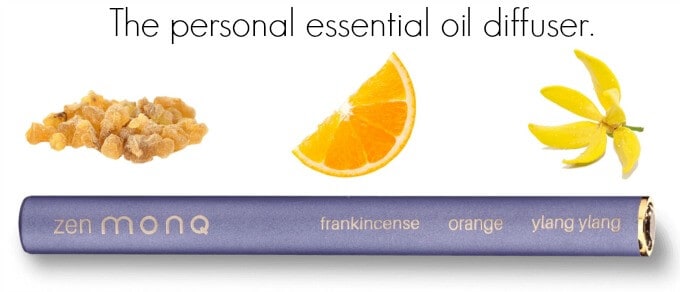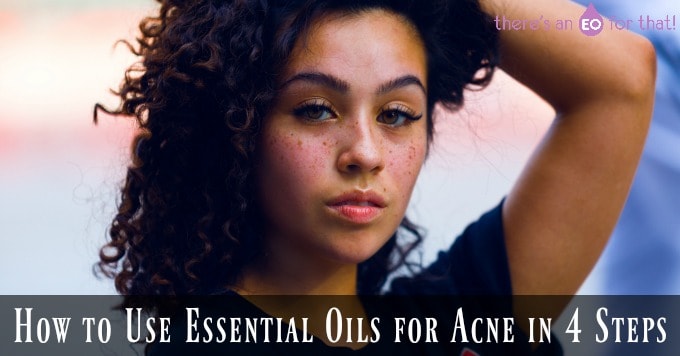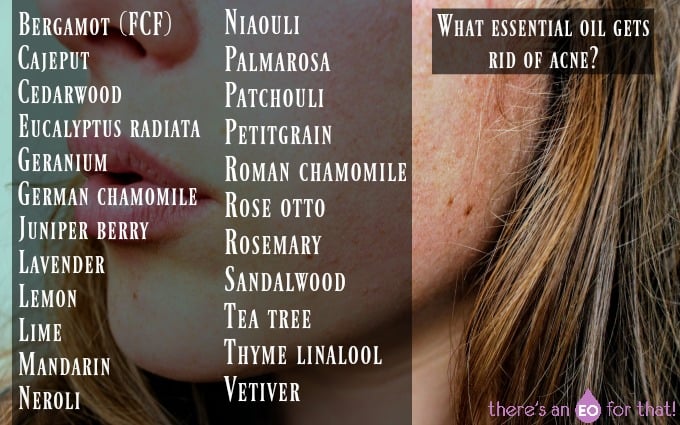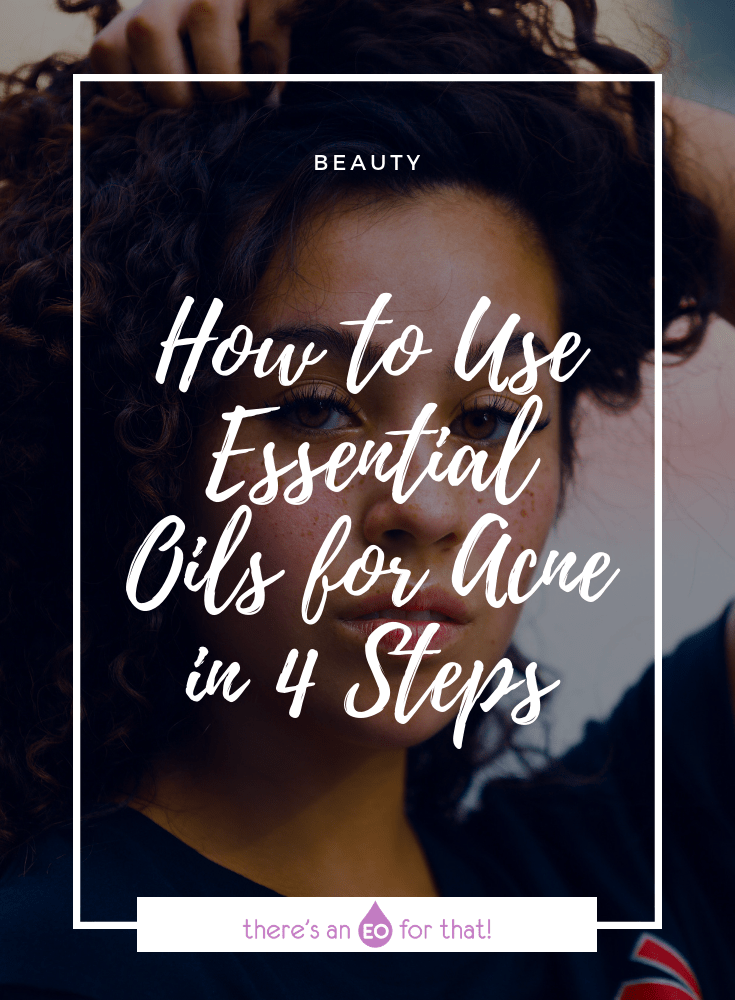Acne used to be one of those things I struggled with for YEARS until I learned how to heal it and keep it from coming back. Aside from the usual lifestyle changes like eating a healthy diet, getting more exercise, controlling stress, and sleeping more, I used specific essential oils for acne in my homemade skincare recipes to help heal my breakouts from the outside in.
Since I have had such tremendous success using essential oils in this way, I thought it prudent to share my experience so that others can achieve clearer skin.
So, let’s hop right in, shall we?
Essential Oils for Acne and How to Use Them in 4 Steps
Acne is an inflammatory skin condition that affects 70-80 percent of Americans at some point in their lives (source). I’m 33 and still get the occasional spot near my cycle, but since using a few essential oils to help support my skin’s healing, my chronic breakouts and cystic acne are gone.
Here are the steps I took to clear my acne using essential oils.
Therapeutic Strategy for Clearing Acne
Since acne is caused by a complex interaction between hormones, sebum production, bacteria, and cell turnover, it’s important to implement a multifaceted approach in order to get rid of it.
This means making the appropriate lifestyle changes where necessary, getting your hormones tested so that you can pinpoint hormonal imbalances and correct them, and use essential oils topically to help control sebum and bacteria while promoting faster healing.
Some of the best essential oils for acne help by:
- Clearing the infection by eliminating acne-causing bacteria
- Reducing inflammation
- Reducing sebum production
- Reducing stress
- Supporting hormonal balance
- Supporting the body’s elimination pathways
- Supporting the skin’s healing process
(source)
Being able to do all of these things is the key to achieving clear skin, but which essential oils are good for acne that support these needs?
What essential oil gets rid of acne?
In general, the best essential oils for acne include:
- Bergamot (FCF)
- Cajeput
- Cedarwood
- Eucalyptus radiata
- Geranium
- German chamomile
- Juniper berry
- Lavender
- Lemon
- Lime
- Mandarin
- Neroli
- Niaouli
- Palmarosa
- Patchouli
- Petitgrain
- Roman chamomile
- Rose otto
- Rosemary
- Sandalwood
- Tea tree
- Thyme linalool
- Vetiver
New research has also suggested rosewood essential oil (can sub Ho Wood for a similar result) to be an excellent candidate for controlling acne. (source)
Since this is an extensive list, I will break the essential oils down into more digestible groups below so that you can easily target what your skin and body need.
It can seem a bit overwhelming but I promise that it’s actually quite easy to choose 2-3 oils and make up your own unique blends.
How do you use essential oils for acne?
Step One – Eliminate Acne-Causing Bacteria
This is going to be a must for everyone who suffers from acne since acne wouldn’t exist without the bacteria Cutibacterium acnes (formerly Propionibacterium acnes).
In order to effectively control acne-causing bacteria, you need to use antiseptic essential oils like:
- Bergamot (FCF)
- Eucalyptus radiata
- Lavender (great when diffused for stress relief)
- Lemon
- Niaouli
- Petitgrain
- Tea tree
- Thyme linalool
These oils are best used as spot treatments on active unopened skin or in facial serums used on problem areas 2-3 times daily.
A few of my go-to oils include thyme, tea tree, and lavender.
Thyme essential oil, in particular, has been proven to be just as effective as Benzoyl peroxide for killing acne-causing bacteria and is, therefore, a star ingredient whenever I make homemade spot treatments. (source)
Tea tree essential oil is another proven essential oil that is known to actually help drastically reduce the number of pimples that form due to its antimicrobial and anti-inflammatory effects. (source)
Lavender essential oil doubles as an effective topical acne treatment while also reducing stress and improving quality of sleep. Since acne and stress are so closely connected, lavender is the perfect essential oil to not only use on the skin itself but diffused throughout the room.
Here are a couple of recipes I often reach for when dealing with breakouts.
Anti-Acne Spot Treatment Roll-On Recipe
You will need:
- One 10ml roll-on bottle
- Jojoba oil
- 1 drop thyme linalool essential oil
- 3 drops tea tree essential oil
Add all of the ingredients to the roll-on bottle, cap closed, and roll between your palms to mix.
Apply to unopen pimples and problem areas 2-3 times daily to help eliminate bacteria and heal existing breakouts.
Acne Serum Recipe
You will need:
- One 1 oz dropper bottle
- Carrier oil (I like 50/50 jojoba and evening primrose oil)
- 2 drops thyme linalool essential oil
- 3 drop tea tree essential oil
- 3 drops niaouli essential oil
- 4 drops eucalyptus radiata essential oil
Add all of the ingredients to the 1 oz dropper bottle, cap closed, and roll between the palms to mix.
Spritz clean skin with rose water and apply 2-3 drops of serum where needed to help control acne breakouts 1-2 times daily.
Step Two – Bring Down Inflammation
Reducing inflammation is another key factor when healing acne and lessening its appearance. This will reduce redness while also reducing the pain of deep cystic acne.
Anti-inflammatory essential oils for acne include:
- Bergamot (FCF)
- Cedarwood
- Copaiba
- Eucalyptus radiata
- Frankincense
- Geranium
- German chamomile
- Helichrysum
- Lavender
- Myrrh
- Patchouli
- Peppermint
- Roman chamomile
- Sandalwood
- Tea tree
These essential oils can be used in facial oils, serums, masks, or in toner mists. Some of my particular favorites from this list include sandalwood and German chamomile.
Anti-Inflammatory Clay Mask
I love to make a sandalwood clay mask by mixing 1 drop of sandalwood essential oil with 1 TB of facial clay. Not only does the clay pull impurities from the skin, it also reduces inflammation and redness which helps my skin look smoother and fresh. The sandalwood essential oil also eliminates inflammation and helps the skin heal more quickly.
Step Three – Reduce Sebum Production
This is one of the most important steps aside from controlling acne-causing bacteria. If you can’t control sebum production or at least keep cellular turnover steady, you will almost always suffer from new breakouts.
Sebum is one of the food sources that acne-causing bacteria need to flourish. It’s also partly responsible for the formation of pimples if it gets trapped by dead skin cells in the pores. This buildup of sebum is what causes whiteheads and blackheads to clog the pores and get infected.
Thankfully, there are a few essential oils that specifically target the overproduction of sebum in the skin.
These include:
- Eucalyptus globulus (proven to reduce the size of sebaceous glands) (source)
- Geranium (this is by far the best for controlling sebum)
- Lavender
- Lemon
- Roman Chamomile
- Tea tree
Anti-Sebum Toner Recipe
You will need:
- One 1 oz spray bottle
- Witch hazel
- 1 drop lemon essential oil (omit if you plan to use it the during the day)
- 2 drops geranium essential oil
- 2 drops tea tree essential oil
Add the ingredients to the 1 oz spray bottle, cap closed, and shake well before use. Spray onto a cotton pad and wipe gently over the skin, concentrating on problem areas once daily.
Essential Oil Face Wash for Acne
This is a recipe I use on occasion that helps cleanse the skin while also helping to control excess sebum production.
You will need:
- One foaming soap dispenser
- 2/3 castile soap
- 1/3 cup rose water
- 1 TB of jojoba oil
- 20 drop geranium essential oil
- 20 drops lavender essential oil
- 5 drops grapefruit essential oil
- Preservative of choice
Add all of the ingredients to the foaming soap dispenser and shake to mix. Use as a facial cleanser 1-2 times daily. I generally use it a few times per week.
Step Four – Control Hormones
Since the topic of hormones is so complicated and involved, I encourage you to check out this blog post (and this one) to see how you can use essential oils to help balance hormones.
I don’t recommend using these oils as described unless you have had your hormones tested and actually know which ones are out of balance or you might make things tilt in the wrong direction!
However, you can still research essential oils while you wait for your results.
Some of the best essential oils for hormone balance include:
What have been your favorite essential oils for acne? Please share them in the comments below!
You may also enjoy reading:
How to Boost Fertility with Essential Oils
The Best Essential Oils for Fertility
How to treat Acne Inside and Out
Essential Oil Quick Usage Guide – Acne
Other Sources
Bassett, Ingrid B., Ross St C. Barnetson, and Debra L. Pannowitz. “A comparative study of tea‐tree oil versus benzoylperoxide in the treatment of acne.” Medical Journal of Australia 153.8 (1990): 455-458.
Enshaieh, Shahla, et al. “The efficacy of 5% topical tea tree oil gel in mild to moderate acne vulgaris: a randomized, double-blind placebo-controlled study.” Indian Journal of Dermatology, Venereology, and Leprology 73.1 (2007): 22.
Carson, C. F., and T. V. Riley. “Antimicrobial activity of the essential oil of Melaleuca alternifolia.” Letters in Applied Microbiology 16.2 (1993): 49-55.
 This post contains affiliate links. We are a participant in the Amazon Services LLC Associates Program, an affiliate advertising program designed to provide a means for us to earn fees by linking to Amazon.com and affiliated sites. Please read my full disclosure and disclaimer.
This post contains affiliate links. We are a participant in the Amazon Services LLC Associates Program, an affiliate advertising program designed to provide a means for us to earn fees by linking to Amazon.com and affiliated sites. Please read my full disclosure and disclaimer. 



Leave a Reply